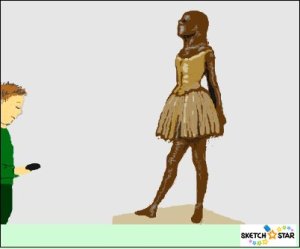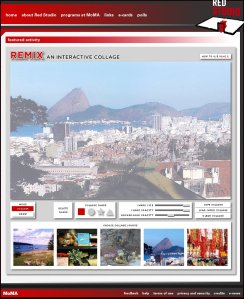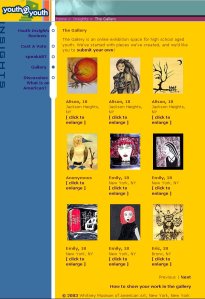CREATION AND PARTICIPATION
Regarding creation and participation, Lenhardt and Madden refer to teens in their 2005 Pew Internet study as media creators, due to the fact that
57% of online teens create content for the internet, 33% of online teens share their own creations online, 32% say they have created or worked on webpages or blogs for others, 22% report keeping their own personal webpage, 19% have created their own online journal or blog, and 19% say they remix content they find online into their own artistic creations. (p. i)
Tate Kids has one of the most interactive websites for all visitors. The section Games features eight online activities that are classified by three levels of difficulty from simple paintbrush manipulation to their most recent game, an online contest based on Edgar Degas’ sculpture The Little Dancer. For this contest, the Tate partnered with Miniclip to promote their new animation tool Sketch Star. By using the tool, kids must imagine what the little dancer would do inside the museum if she escaped from her case. The game commenced on September 14, 2009 and a video was posted on YouTube. In the first five days there were 2,687 views of the video and 23 comments on the Tate Kids blog. The contest ended on September 24, 2009 with 2,125 entries. The first place winner was boiledsprout.
Tate Kids also features My Gallery where kids can create their own art gallery based on images in the Tate Kids Collection. An important element of this section is that the public can browse other galleries; they can search for them by username and location, and can search for favorites in the Tate Kids Collection that are listed by username. There is also a featured Gallery of the month with a photo and brief profile of its creator. Tate Kids does not offer a space for kids to upload their own artwork, however in Tate Create (offline crafty activities) they state, “Try them yourself then send us your pictures.” The problem is that there are no directions on how to send the pictures (is there a Flickr site? to the general email?). The Young Tate is more directed towards active participation due to the Manifesto for a Creative Britain, as has been described in the Case Studies post, and there is also a call for the public to submit podcasts they have created about art by sending the link.
Many of the online activities at Red Studio (MoMA) have already been mentioned, such as Chance Words, Fauxtogram, and Remix. Unfortunately these activities – like the Games on Tate Kids – are individual ones that do not get shared with others on the website. It is also interesting to note that the images MoMA uploaded for users to remix are not from the museum collection, but rather generic snapshots of an exotic marketplace, a construction site, the beach, the countryside, and toys. There is a Character Sketch Contest on its home page announcing “Winners Now Posted!” but the contest ended in June 2006.
The NMMA’s Radio Arte website offers a live stream of its radio broadcast, available both in regular and high definition, and they have a photo stream on Flickr for the teenagers to upload photos, tag, and comment. Another means of teen participation is monetary, and Radio Arte is the only website that encourages teens to contribute to their organization, with Donate Now! clearly presented on the home page linking to an online payment system.
The Whitney’s Youth2Youth website features a Gallery section that is an “online exhibition space for high school aged youth.” It is not limited to teen council members, stating “We’ve started with pieces we’ve created, and we’d like you to submit your own!” The images are listed by username, age, location, and there is a hyperlink to specific directions on how to submit works. The Walker’s WACTAC website offers no activities or online gallery, but in the Art section under Pages, there is a list of cryptic headings such as 20 Under 20, 2010 Girls in the Directors Chair Application, and TCYMN Application. These and the other headings are actually calls for public participation and submission of artwork for contests, exhibitions, festivals, and the museum’s teen art council. Active participation on the website is limited to its members (who need a username and password); the only other opportunity for outsiders to contribute or interact is to view the content and submit comments or questions in response to the postings.
It is necessary to briefly discuss how each of these teen websites differ in presenting opportunities for creation and participation. While much of the literature on teenagers and new media focuses on their interest in actively participating and creating, there are many other equally valid means for teens to participate online that are more passive in nature. Participating in these teen websites starts with the general public browsing through the information provided, viewing peer profiles, galleries, artwork, learning about museum activities, finding helpful links, and enjoying art. These websites are driven by the active participation of museum-based groups or members (except for Tate Kids), with much of their information online directed only to members. However, these are also public websites that present their information and creative works onto a public forum for feedback, encouragement, and simply to have an audience. Most of the teenagers – both members and outsiders – create podcasts and interviews that can be downloaded from the websites (Red Studio, WACTAC, Radio Arte). Certainly it is highly desirable for outside teenagers to become inspired enough by browsing these websites to start actively contributing and participating, seeking further knowledge and exploring the museum and its collections. However, the more passive acts of an anonymous audience on the web is also an important validating act for these teen websites, and must be clearly distinguished from the active participation of inside members.



Comments are closed.